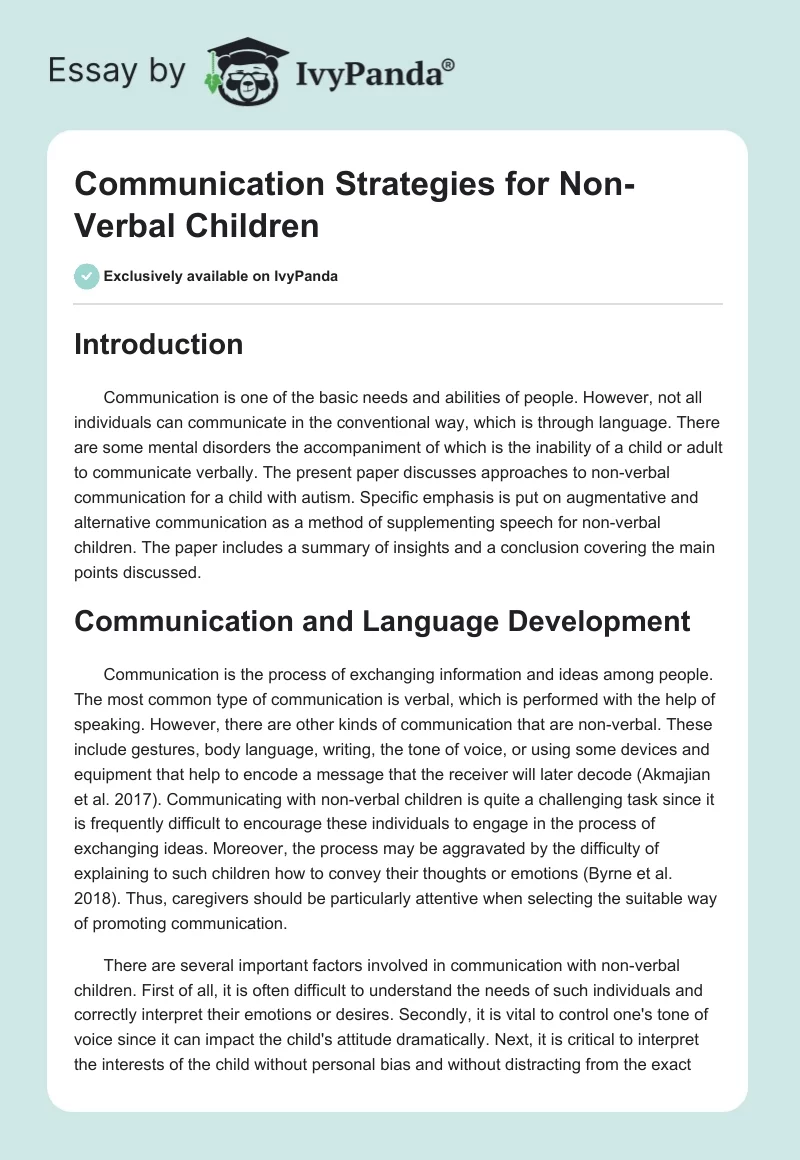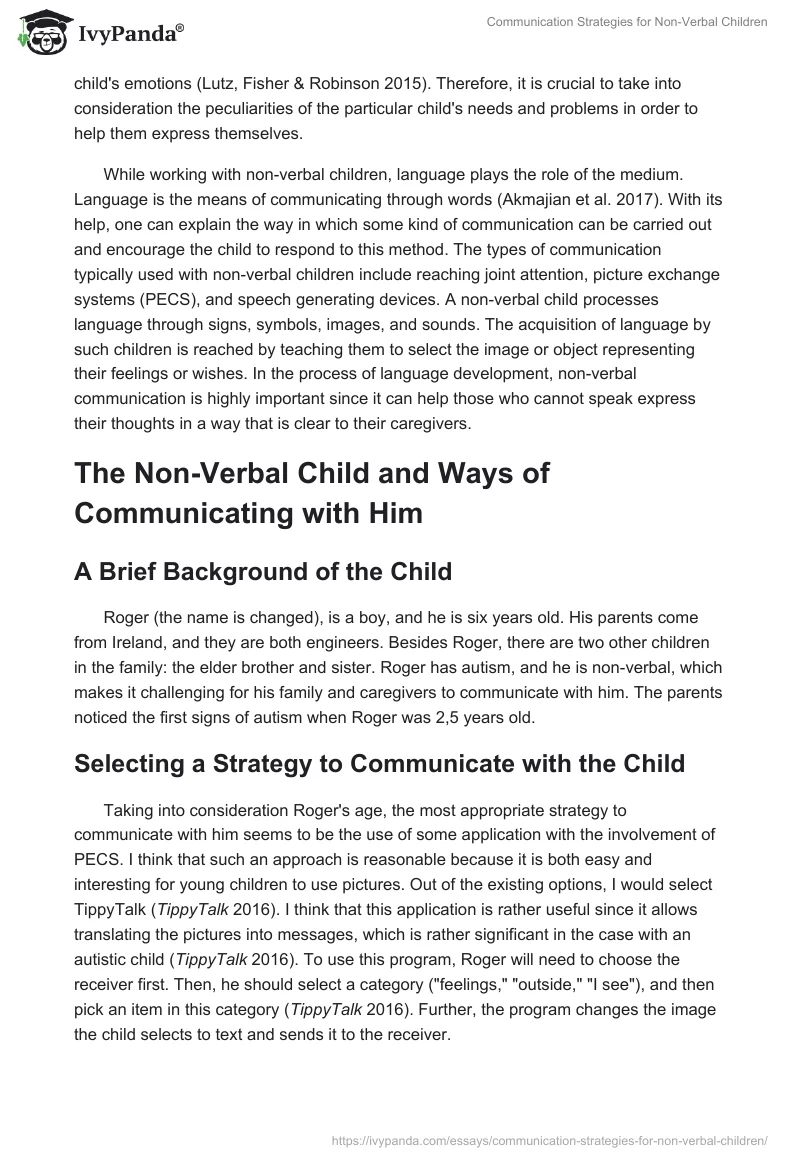Introduction
Communication is one of the basic needs and abilities of people. However, not all individuals can communicate in the conventional way, which is through language. There are some mental disorders the accompaniment of which is the inability of a child or adult to communicate verbally. The present paper discusses approaches to non-verbal communication for a child with autism. Specific emphasis is put on augmentative and alternative communication as a method of supplementing speech for non-verbal children. The paper includes a summary of insights and a conclusion covering the main points discussed.
Communication and Language Development
Communication is the process of exchanging information and ideas among people. The most common type of communication is verbal, which is performed with the help of speaking. However, there are other kinds of communication that are non-verbal. These include gestures, body language, writing, the tone of voice, or using some devices and equipment that help to encode a message that the receiver will later decode (Akmajian et al. 2017). Communicating with non-verbal children is quite a challenging task since it is frequently difficult to encourage these individuals to engage in the process of exchanging ideas. Moreover, the process may be aggravated by the difficulty of explaining to such children how to convey their thoughts or emotions (Byrne et al. 2018). Thus, caregivers should be particularly attentive when selecting the suitable way of promoting communication.
There are several important factors involved in communication with non-verbal children. First of all, it is often difficult to understand the needs of such individuals and correctly interpret their emotions or desires. Secondly, it is vital to control one’s tone of voice since it can impact the child’s attitude dramatically. Next, it is critical to interpret the interests of the child without personal bias and without distracting from the exact child’s emotions (Lutz, Fisher & Robinson 2015). Therefore, it is crucial to take into consideration the peculiarities of the particular child’s needs and problems in order to help them express themselves.
While working with non-verbal children, language plays the role of the medium. Language is the means of communicating through words (Akmajian et al. 2017). With its help, one can explain the way in which some kind of communication can be carried out and encourage the child to respond to this method. The types of communication typically used with non-verbal children include reaching joint attention, picture exchange systems (PECS), and speech generating devices. A non-verbal child processes language through signs, symbols, images, and sounds. The acquisition of language by such children is reached by teaching them to select the image or object representing their feelings or wishes. In the process of language development, non-verbal communication is highly important since it can help those who cannot speak express their thoughts in a way that is clear to their caregivers.
The Non-Verbal Child and Ways of Communicating with Him
A Brief Background of the Child
Roger (the name is changed), is a boy, and he is six years old. His parents come from Ireland, and they are both engineers. Besides Roger, there are two other children in the family: the elder brother and sister. Roger has autism, and he is non-verbal, which makes it challenging for his family and caregivers to communicate with him. The parents noticed the first signs of autism when Roger was 2,5 years old.
Selecting a Strategy to Communicate with the Child
Taking into consideration Roger’s age, the most appropriate strategy to communicate with him seems to be the use of some application with the involvement of PECS. I think that such an approach is reasonable because it is both easy and interesting for young children to use pictures. Out of the existing options, I would select TippyTalk (TippyTalk 2016). I think that this application is rather useful since it allows translating the pictures into messages, which is rather significant in the case with an autistic child (TippyTalk 2016). To use this program, Roger will need to choose the receiver first. Then, he should select a category (“feelings,” “outside,” “I see”), and then pick an item in this category (TippyTalk 2016). Further, the program changes the image the child selects to text and sends it to the receiver.
Determining the Child’s Existing Communication Abilities and Analysing Challenges
To assess Roger’s existing communication abilities, I will arrange an eye contact with him and try using different tones of voice. I will analyse whether the boy reacts to the change of pitch. Also, I will observe his repetitive motor movements and try to single out the objects or movements he particularly prefers. Then, I will use the same or similar objects and make the same movements to see whether he will engage in social interaction with me. Another highly productive approach I will try is a relationship development intervention (Therapies & interventions 2018). By these actions, I will motivate Roger to communicate with me or to initiate communication.
Prior to selecting the communication approach, I will consider the following factors and challenges. First of all, I will be alert in case some unpredicted reaction appears to my attempts to communicate. Secondly, I realise that there is a challenge of Roger being unwilling to engage in communication with me, and I will need to be extremely patient and persistent to reach the desired result (Roberts et al. 2018). Finally, I will need to take into consideration his preferences and make sure that he understands the concept of friendship and friendly relations (Potter 2014). By considering these factors, I will be better prepared for the boy’s reactions and will be able to come up with viable solutions.
Augmentative and Alternative Communication
Augmentative and alternative communication (AAC) is an umbrella term employed to describe different communication methods used to cope with speech predicaments. The system of AAC incorporates both simple and complex elements, varying from pointing, gestures, and pictures to powerful computer technologies (The Communication Trust 2018; Gillespie-Smith & Fletcher-Watson 2014). AAC is reported to be more beneficial for children than adults (Hagan & Thompson 2013). The benefits of using AAC include better assimilation into society and the improved communication of an autistic child.
The Use of PECS
PECS are some of the most common types of non-verbal communication included in AAC. When using this approach, caregivers or parents help children with no verbal ability to explain their thoughts with the help of images Therapies & interventions 2018). The first phase of PECS involves selecting the most motivational pictures and teaching the child that he or she can receive the object they want by giving the card to the caregiver. During the second phase, the child has to come over to the educator and hand over the card to them. In this way, the child learns to draw someone’s attention (Therapies & interventions 2018). In later phases, more than one picture is offered to the child so that they could select what they want.
Benefits of Various AAC methods and Factors to Take into Consideration
PECS, as well as other AAC approaches, such as barrier communication games, social scripts, storytelling, and the use of poetry, have numerous benefits for children. In particular, they help autistic children to express their desires and teach them to choose between alternatives (Schlosser & Koul 2015). Barrier games teach children to exchange information, so they develop both communication and social skills (Great idea: barrier games 2017). Using poetry allows educators to increase the child’s literacy opportunities (The Communication Trust 2018). Storytelling and social scripts help to manage autistic children’s challenging behaviour (Wright et al. 2016). When using any of these methods, it is crucial to keep in mind the factors involved in AAC, such as the child’s age, health and safety, the level of readiness, and his or her social behaviour characteristics.
Summary of Insights
Learning about communication strategies for a non-verbal child has enriched my professional outlook to a great extent. My existing knowledge and attitudes have altered since I have found out about a variety of methods to employ while working with autistic children. Also, I have learned that it is highly important to take into consideration many possible complications and challenges since not every child can be approached with a method I would prefer. In my opinion, society’s attitude towards autistic children is prejudiced. With appropriate methods, they can be educated and can be taught how to assimilate in society.
Conclusion
The project analyses one of the most significant topics related to developmental disorders ─ non-verbal communication with autistic children. The paper discusses the challenges and opportunities for parents, caregivers, and educators of such children. Augmentative and alternative communication techniques are given a special prominence as a highly prospective methodology. The peculiarities of non-verbal communication are discussed with a particular regard to picture exchange systems as the selected approach to an autistic child.
Reference List
Akmajian, A, Farmer, A, Bickmore, L, Demers, R & Harnish, RM 2017, Linguistics: an introduction to language and communication, 7th edn, London, The MIT Press.
Byrne, G, Sarma, KM, Hendler, J & O’Connell, A 2018, ‘On the spectrum, off the beaten path. A qualitative study of Irish parents’ experiences of raising a child with autism spectrum conditions’, British Journal of Learning Disabilities, pp. 1-11.
The Communication Trust 2018, Alternative paths to literacy: literacy support for children and young adults who use AAC, Web.
Gillespie-Smith, K & Fletcher-Watson, S 2014, ‘Designing AAC systems for children with autism: evidence from eye tracking research’, Augmentative and Alternative Communication, vol. 30, no. 2, pp. 160-171.
Great idea: barrier games 2017, Web.
Hagan, L & Thompson, H 2013, ‘It’s good to talk: developing the communication skills of an adult with an intellectual disability through augmentative and alternative communication’, British Journal of Learning Disabilities, vol. 42, pp. 68-75.
Lutz, D, Fisher, KR & Robinson, S 2015, ‘Sharing the focus: engaging with support workers to include people with communication needs in research’, British Journal of Learning Disabilities, vol. 44, pp. 138-145.
Potter, C 2014, ‘”I didn’t used to have much friends”: exploring the friendship concepts and capabilities of a boy with autism and severe learning disabilities’, British Journal of Learning Disabilities, vol. 43, pp. 208-218.
Roberts, H, Ingold, A, Liabo, K, Manzotti, G, Reeves, D & Bradby, H 2018, ‘Moving on: transitions out of care for young people with learning disabilities in England and Sweden’, British Journal of Learning Disabilities, vol. 46, pp. 54-63.
Schlosser, RW & Koul, RK 2015, ‘Speech output technologies in interventions for individuals with autism spectrum disorders: a scoping review’, Augmentative and Alternative Communication, vol. 31, no. 4, pp. 285-309.
Therapies & interventions 2018, Web.
TippyTalk2016, Web.
Wright, B, Marshall, D, Adamson, J, Ainsworth, H, Ali, S, Allgar, V, Moore, DC, Cook, E, Dempster, P, Hackney, L, McMillan, D, Trepél, D & Williams, C 2016, ‘Social Stories™ to alleviate challenging behaviour and social difficulties exhibited by children with autism spectrum disorder in mainstream schools: design of a manualised training toolkit and feasibility study for a cluster randomised controlled trial with nested qualitative and cost-effectiveness components’, Health Technology Assessment, vol. 20, no. 6, pp. 1-258.


